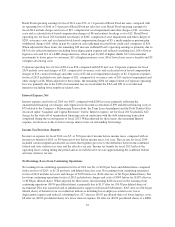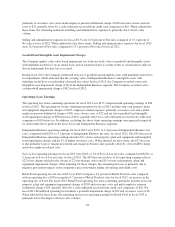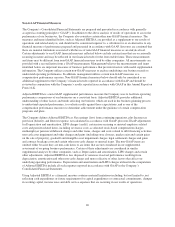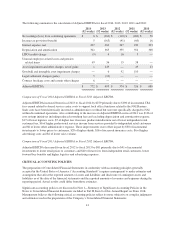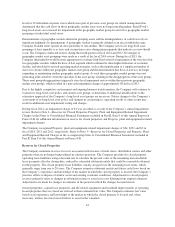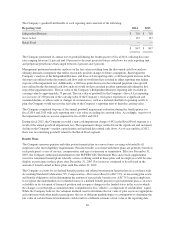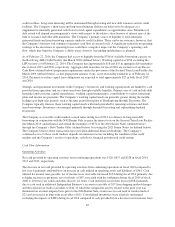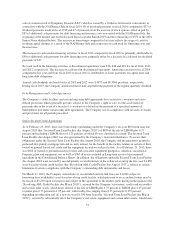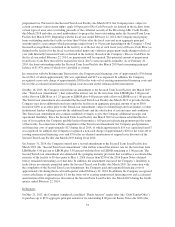Albertsons 2014 Annual Report Download - page 46
Download and view the complete annual report
Please find page 46 of the 2014 Albertsons annual report below. You can navigate through the pages in the report by either clicking on the pages listed below, or by using the keyword search tool below to find specific information within the annual report.level for 29 individual corporate stores which were part of previous asset groups for which management has
determined that the cash flows in those geographic market areas were no longer interdependent. Retail Food’s
long-lived assets are reviewed for impairment at the geographic market group level for five geographic market
groupings of individual retail stores.
Determinations of geographic markets utilized in grouping assets and the interdependency of cash flows rely on
significant judgments by management. A geographic market is generally defined as an area in which the same
Company-branded stores operate in close proximity to one another. The Company reviews its long-lived asset
groupings at least annually or as facts and circumstances arise during interim periods that indicate a review should
occur. The Company conducted reviews during the fourth quarter of fiscal 2014 and 2013. No changes to
geographic market asset groupings were made as a result of the fiscal 2014 review. During fiscal 2013, the
Company determined it would be more appropriate to evaluate long-lived assets for impairment at the store level for
two geographic markets within the Save-A-Lot segment which continued to show higher indicators of economic
decline, and which led to revised operating market strategies, such as the identification of a significant number of
stores for closure within one geographic market asset group and the determination that Save-A-Lot was no longer
expanding or maintaining another geographic market group. As such these geographic market groups were not
generating joint cash flows from the operation of the asset group, resulting in the disaggregation of the asset groups.
These asset group disaggregations triggered a store-level impairment review within these previous geographic
market asset groups, which resulted in a non-cash impairment charge of approximately $8 in fiscal 2013.
Due to the highly competitive environment and ongoing business transformation, the Company will continue to
evaluate its long-lived asset policy and current asset groups, to determine if additional modifications to the
estimation approach of the Company’s long-lived asset groups are necessary. Future changes to the Company’s
assessment of its long-lived asset policy and changes in circumstances, operating results or other events may
result in additional asset impairment testing and charges.
During fiscal 2014, an impairment charge of $1 was recorded as a result of the Company’s annual impairment
review. Refer to Note 3—Reserves for Closed Properties Property, Plant and Equipment-Related Impairment
Charges in the Notes to Consolidated Financial Statements included in Part II, Item 8 of this Annual Report on
Form 10-K for additional information on reserve for closed properties and Property, plant and equipment-related
impairment charges.
The Company recognized Property, plant and equipment-related impairment charges of $24, $251 and $3 in
fiscal 2014, 2013 and 2012, respectively. Refer to Note 3—Reserves for Closed Properties and Property, Plant
and Equipment Related Charges in the accompanying Notes to Consolidated Financial Statements included in
Part II, Item 8 of this Annual Report on Form 10-K
Reserves for Closed Properties
The Company maintains reserves for costs associated with closures of retail stores, distribution centers and other
properties that are no longer being utilized in current operations. The Company provides for closed property
operating lease liabilities using a discount rate to calculate the present value of the remaining noncancellable
lease payments after the closing date, reduced by estimated subtenant rentals that could be reasonably obtained
for the property. The closed property lease liabilities usually are paid over the remaining lease terms, which
generally range from one to 20 years. The Company estimates subtenant rentals and future cash flows based on
the Company’s experience and knowledge of the market in which the closed property is located, the Company’s
previous efforts to dispose of similar assets and existing economic conditions. Adjustments to closed property
reserves primarily relate to changes in subtenant income or actual exit costs differing from original estimates.
Adjustments are made for changes in estimates in the period in which the changes become known.
Owned properties, capital lease properties and the related equipment and leasehold improvements at operating
leased properties that are closed are reduced to their estimated fair value. The Company estimates fair value
based on its experience and knowledge of the market in which the closed property is located and, when
necessary, utilizes local real estate brokers to assist in the valuation.
44



